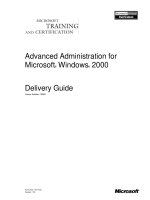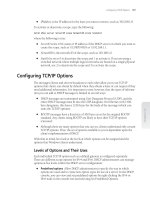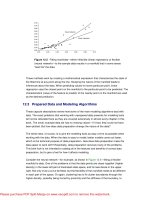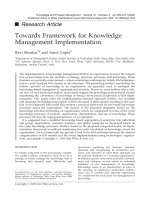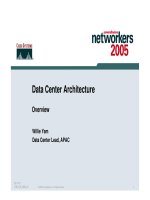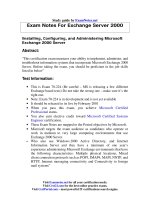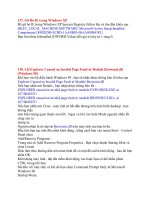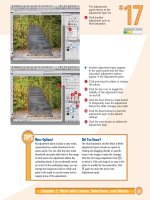Tài liệu Data Preparation for Data Mining- P16 ppt
Bạn đang xem bản rút gọn của tài liệu. Xem và tải ngay bản đầy đủ của tài liệu tại đây (184.36 KB, 16 trang )
Figure 12.5 Fitting manifolds—either inflexible (linear regression) or flexible
(neural network)—to the sample data results in a manifold that in some sense
“best fits” the data.
These methods work by creating a mathematical expression that characterizes the state of
the fitted line at any point along the line. Studying the nature of the manifold leads to
inferences about the data. When predicting values for some particular point, linear
regression uses the closest point on the manifold to the particular point to be predicted. The
characteristics (value of the feature to predict) of the nearby point on the manifold are used
as the desired prediction.
12.3 Prepared Data and Modeling Algorithms
These capsule descriptions review how some of the main modeling algorithms deal with
data. The exact problems that working with unprepared data presents for modeling tools
will not be reiterated here as they are covered extensively in almost every chapter in this
book. The small, example data set has no missing values—if it had, they could not have
been plotted. But how does data preparation change the nature of the data?
The whole idea, of course, is to give the modeling tools as easy a time as possible when
working with the data. When the data is easy to model, better models come out faster,
which is the technical purpose of data preparation. How does data preparation make the
data easier to work with? Essentially, data preparation removes many of the problems.
This brief look is not intended to catalog all of the features and benefits of correct data
preparation, but to give a feel for how it affects modeling.
Consider the neural network—for example, as shown in Figure 12.5—fitting a flexible
manifold to data. One of the problems is that the data points are closer together (higher
density) in the lower-left part of illustrated state space, and far less dense in the upper
right. Not only must a curve be fitted, but the flexibility of the manifold needs to be different
in each part of the space. Or again, clustering has to fit cluster boundaries through the
higher density, possibly being forced by proximity and the stiffness of the boundary, to
Please purchase PDF Split-Merge on www.verypdf.com to remove this watermark.
include points that should otherwise be excluded. Or again, in the nearest-neighbor
methods, neighborhoods were unbalanced.
How does preparation help? Figure 12.6 shows the data range normalized in state space
on the left. The data with both range and distribution normalized is shown on the right.
The range-normalized and redistributed space is a “toy” representation of what full data
preparation accomplishes. This data is much easier to characterize—manifolds are more
easily fitted, cluster boundaries are more easily found, neighbors are more neighborly.
The data is simply easier to access and work with. But what real difference does it make?
Figure 12.6 Some of the effects of data preparation: normalization of data range
(left), and normalization and redistribution of data set (right).
12.3.1 Neural Networks and the CREDIT Data Set
The CREDIT data set is a derived extract from a real-world data set. Full data preparation
and surveying enable the miner to build reasonable models—reasonable in terms of
addressing the business objective. But what does data preparation alone achieve in this
data set? In order to demonstrate that, we will look at two models of the data—one on
prepared data, and the other on unprepared data.
Any difficulty in showing the effect of preparation alone is due to the fact that with
ingenuity, much better models can be built with the prepared data in many circumstances
than with the data unprepared. All this demonstrates, however, is the ingenuity of the
miner! To try to “level the playing field,” as it were, for this example the neural network
models will use all of the inputs, have the same number of nodes in the hidden layer, and
will use no extracted features. There is no change in network architecture for the prepared
and unprepared data sets. Thus, this uses no knowledge gleaned from the either the data
assay or the data survey. Much, if not most, of the useful information discovered about the
data set, and how to build better models, is simply discarded so that the effect of the
automated techniques is most easily seen. The difference between the “unprepared” and
“prepared” data sets is, as nearly as can be, only that provided by the automated
preparation—accomplished by the demonstration code.
Now, it is true that a neural network cannot take the data from the CREDIT data set in its
Please purchase PDF Split-Merge on www.verypdf.com to remove this watermark.
raw form, so some preparation must be done. Strictly speaking, then, there is no such
thing—for a neural network—as modeling unprepared data. What then is a fair
preparation method to compare with the method outlined in this book?
StatSoft is a leading maker of statistical analysis software. Their tools reflect statistical
state-of-the art techniques. In addition to a statistical analysis package, StatSoft makes a
neural network tool that uses statistical techniques to prepare data for the neural network.
Their data preparation is automated and invisible to the modeler using their neural
network package. So the “unprepared” data in this comparison is actually prepared by the
statistical preparation techniques implemented by StatSoft. The “prepared” data set is
prepared using the techniques discussed in this book. Naturally, a miner using all of the
knowledge and insights gleaned from the data using the techniques described in the
preceding chapters should—using either preparation technique—be able to make a far
better model than that produced by this na‹ve approach. The object is to attempt a direct
fair comparison to see the value of the automated data preparation techniques described
here, if any.
As shown in Figure 12.7, the neural network architecture selected takes all of the inputs,
passes them to six nodes in the hidden layer, and has one output to predict—BUYER.
Both networks were trained for 250 epochs. Because this is a neural network, the data set
was balanced to be a 50/50 mix of buyers and nonbuyers.
Figure 12.7 Architecture of the neural network used in modeling both the
prepared and unprepared versions of the CREDIT data set predicting BUYER. It is
an all-input, six-hidden-node, one-output, standard back-propagation neural
network.
Figure 12.8 shows the result of training on the unprepared data. The figure shows a
number of interesting features. To facilitate training, the instances were separated into
training and verification (test) data sets. The network was trained on the training data set,
Please purchase PDF Split-Merge on www.verypdf.com to remove this watermark.
and errors in both the training and verification data sets are shown in the “Training Error
Graph” window. This graph shows the prediction errors made in the training set on which
the network learned, and also shows the prediction errors made in the verification data
set, which the network was not looking at, except to make this prediction. The lower, fairly
smooth line is the training set error, while the upper jagged line shows the verification set
error.
Figure 12.8 Errors in the training and verification data sets for 250 epochs of
training on the unprepared CREDIT data set predicting BUYER. Before the
network has learned anything, the error in the verification set is near its lowest at
2, while the error in the training set is at its highest. After about 45 epochs of
training, the error in the training set is low and the error in the verification set is at
its lowest—about 50% error—at 1.
As the training set was better learned, so the error rate in the training set declined. At first,
the underlying relationship was truly being learned, so the error rate in the verification
data set declined too. At some point, overtraining began, and the error in the training data
set continued to decline but the error in the verification data set increased. At that point,
the network was learning noise.
In this particular example, in the very early epochs—long before the network actually
learned anything—the lowest error rate in the verification data set was discovered! This is
happenstance due to the random nature of the network weights. At the same time, the
error rate in the training set was at its highest, so nothing of value was learned by then.
Looking at the graph shows that as learning continued, after some initial jumping about,
the relationship in the verification data set was at its lowest after about 45 epochs. The
error rate at that point was about 0.5. This is really a very poor performance, since 50% is
exactly the same as random guessing! Recall that the balanced data set has 50% of
buyers and nonbuyers, so flipping a fair coin provides a 50% accuracy rate. It is also
notable that the error rate in the training data set continued to fall so that the network
continued to learn noise. So much then for training on the “unprepared” data set.
The story shown for the prepared data set in Figure 12.9 is very different! Notice that the
Please purchase PDF Split-Merge on www.verypdf.com to remove this watermark.
highest error level shown on the error graph here is about 0.55, or 55%. In the previous
figure, the highest error shown was about 90%. (The StatSoft window scales
automatically to accommodate the range of the graph.) In this graph, three things are very
notable. First, the training and verification errors declined together at first, and are by no
means as far separated as they were before. Second, error in the verification declined for
more epochs than before, so learning of the underlying relationship continued longer.
Third, the prediction error in the verification data set fell much lower than in the
unprepared data set. After about 95 epochs, the verification error fell to 0.38, or a 38%
error rate. In other words, with a 38% error rate, the network made a correct prediction
62% of the time, far better than random guessing!
Figure 12.9 Training errors in the prepared data set for identical conditions as
before. Minimum error is shown at 1.
Using the same network, on the same data set, and training under the same conditions,
data prepared using the techniques described here performed 25% better than either
random guessing or a network trained on data prepared using the StatSoft-provided,
statistically based preparation techniques. A very considerable improvement!
Also of note in comparing the performance of the two data sets is that the training set
error in the prepared data did not fall as low as in the unprepared data. In fact, from the
slope and level of the training set error graphs, it is easy to see that the network training in
the prepared data resisted learning noise to a greater degree than in the unprepared data
set.
12.3.2 Decision Trees and the CREDIT Data Set
Exposing the information content seems to be effective for a neural network. But a
decision tree uses a very different algorithm. It not only slices state space, rather than
fitting a function, but it also handles the data in a very different way. A tree can digest
unprepared data, and also is not as sensitive to balancing of the data set as a network.
Does data preparation help improve performance for a decision tree? Once again, rather
than extracting features or using any insights gleaned from the data survey, and taking
Please purchase PDF Split-Merge on www.verypdf.com to remove this watermark.
the CREDIT data set as it comes, how does a decision tree perform?
Two trees were built on the CREDIT data set, one on prepared data, and one on
unprepared data. The tree used was KnowledgeSEEKER from Angoss Software. All of
the defaults were used in both trees, and no attempt was made to optimize either the
model or the data. In both cases the trees were constructed automatically. Results?
The data was again divided into training and test partitions, and again BUYER was the
prediction variable. The trees were built on the training partitions and tested on the test
partitions. Figure 12.10 shows the results. The upper image shows the Error Profile
window from KnowledgeSEEKER for the unprepared data set. In this case the accuracy
of the model built on unprepared data is 81.8182%. With prepared data the accuracy rises
to 85.8283%. This represents approximately a 5% improvement in accuracy. However,
the misclassification rate improves from 0.181818 to 0.141717, which is an improvement
of better than 20%. For decision trees, at least in this case, the quality of the model
produced improves simply by preparing the data so that the information content is best
exposed.
Figure 12.10 Training a tree with Angoss KnowledgeSEEKER on unprepared data
shows an 81.8182% accuracy on the test data set (top) and an 85.8283% accuracy
in the test data for the prepared data set (bottom).
12.4 Practical Use of Data Preparation and Prepared Data
How does a miner use data preparation in practice? There are three separate issues to
address. The first part of data preparation is the assay, described in Chapter 4. Assaying
Please purchase PDF Split-Merge on www.verypdf.com to remove this watermark.
